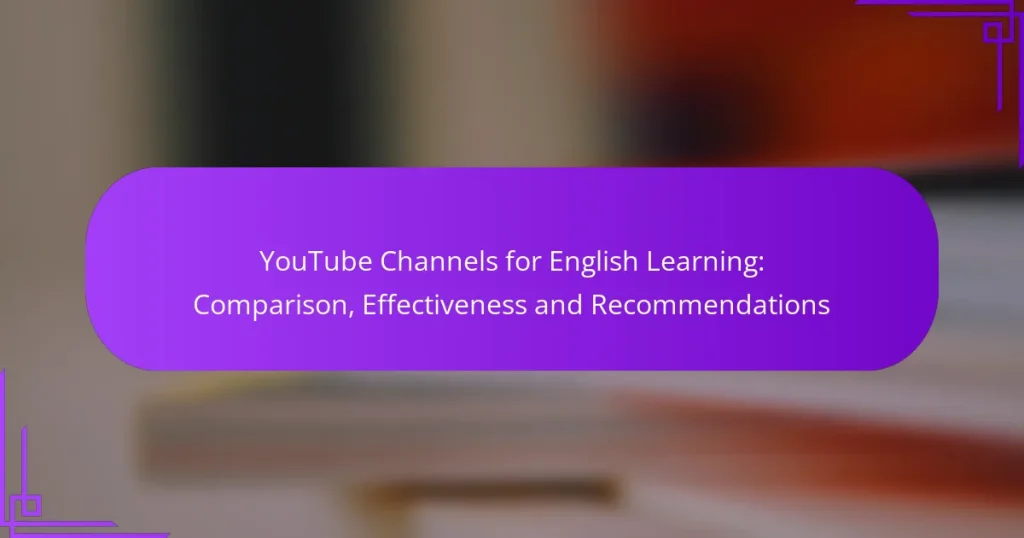YouTube has become a valuable resource for learning English, with numerous channels offering diverse teaching styles and content tailored to different learners. Channels such as BBC Learning English and Rachel’s English emphasize practical skills, while others like EnglishClass101 provide structured lessons suitable for all proficiency levels. The effectiveness of these channels largely hinges on the learner’s engagement and the quality of the content, making it essential to choose wisely based on personal preferences and learning goals.
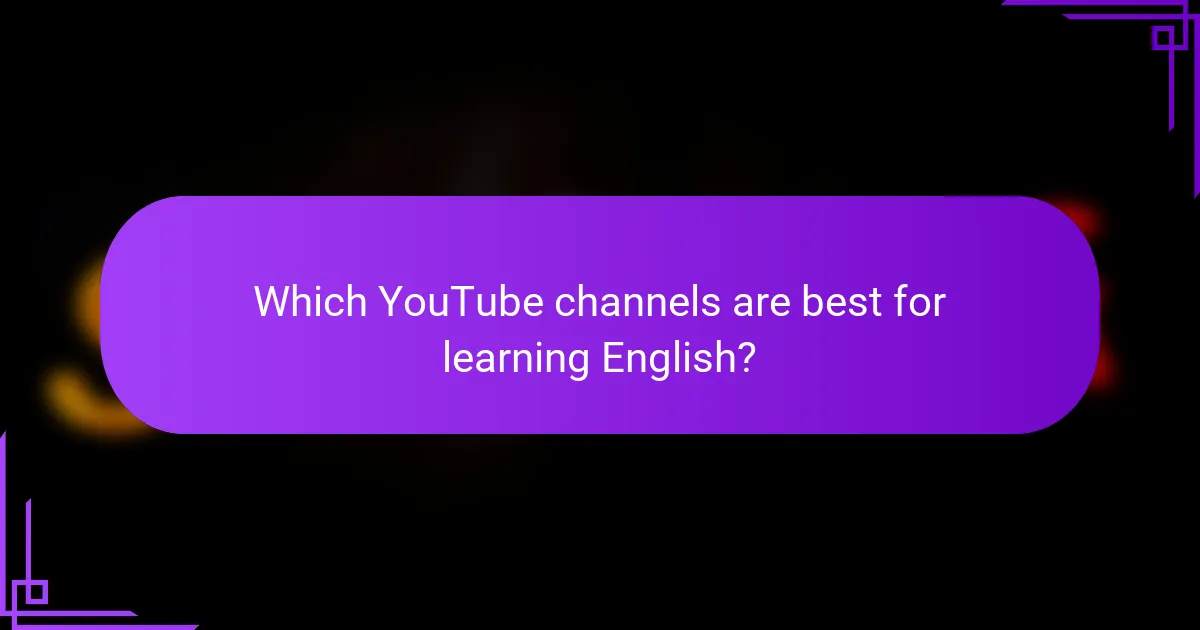
Which YouTube channels are best for learning English?
Some of the best YouTube channels for learning English offer a variety of teaching styles and content types, catering to different learning preferences. Channels like BBC Learning English and Rachel’s English focus on practical language skills, while others like EnglishClass101 provide structured lessons for all levels.
BBC Learning English
BBC Learning English is a well-respected channel that provides high-quality content for English learners. It features a range of videos, including news reports, grammar tips, and vocabulary lessons, all designed to improve listening and speaking skills.
One of the channel’s strengths is its focus on real-world English, often using current events to teach language in context. Regular series like “6 Minute English” offer bite-sized lessons that are easy to digest and perfect for busy learners.
EnglishClass101
EnglishClass101 offers a comprehensive approach to learning English, with lessons tailored to various proficiency levels. The channel features a mix of video lessons, vocabulary lists, and cultural insights, making it a well-rounded resource.
Subscribers can benefit from structured courses that guide them through different aspects of the language. The channel also provides downloadable resources and quizzes to reinforce learning, making it suitable for both casual learners and those seeking a more formal education.
Rachel’s English
Rachel’s English focuses primarily on pronunciation and speaking skills, making it ideal for learners who want to sound more natural. The channel features detailed tutorials on American English sounds, intonation, and rhythm.
Rachel often breaks down complex sounds into manageable parts, providing practical exercises to help learners practice. This channel is particularly useful for non-native speakers looking to improve their accent and fluency in everyday conversations.
Learn English with Emma
Learn English with Emma offers engaging lessons that cover a wide range of topics, including grammar, vocabulary, and idiomatic expressions. Emma’s teaching style is friendly and approachable, making it easy for learners to connect with the material.
The channel also includes tips for studying effectively and overcoming common language learning challenges. Emma often incorporates real-life examples and scenarios, helping learners apply what they’ve learned in practical situations.
VOA Learning English
VOA Learning English provides news and information in simplified English, making it accessible for learners at various levels. The channel features slow-paced news reports and stories that help improve listening comprehension while keeping learners informed about global events.
This channel is particularly beneficial for those interested in current affairs and cultural topics. The use of clear and concise language allows learners to build their vocabulary and understanding of everyday English in a meaningful context.
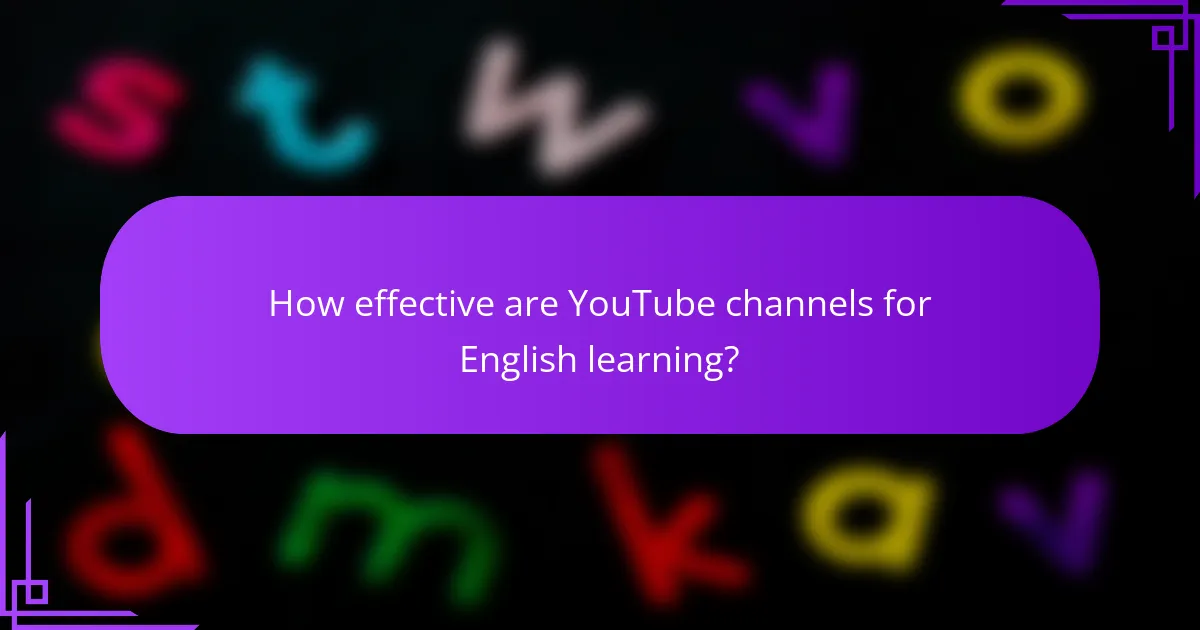
How effective are YouTube channels for English learning?
YouTube channels can be highly effective for learning English, offering accessible content that caters to various proficiency levels. Their effectiveness largely depends on the learner’s engagement, the quality of the content, and the alignment with individual learning preferences.
High engagement levels
YouTube channels often feature dynamic content that captures learners’ attention, making it easier to stay motivated. Engaging formats, such as interactive quizzes and entertaining presentations, can enhance retention and comprehension. Choosing channels with a strong community presence can further boost engagement through comments and discussions.
To maximize engagement, select channels that resonate with your interests, whether they focus on travel, culture, or specific language skills. Regularly participating in discussions or challenges can also keep your learning experience lively.
Variety of learning styles
YouTube channels cater to diverse learning styles, offering visual, auditory, and kinesthetic content. For visual learners, channels that use graphics and animations can clarify complex concepts, while auditory learners benefit from listening to native speakers and engaging with dialogues.
To accommodate different styles, look for channels that provide subtitles, interactive exercises, or even live sessions. This variety allows learners to choose methods that best suit their preferences, enhancing overall effectiveness.
Real-life context exposure
YouTube channels often present language in real-life contexts, helping learners understand practical usage. This exposure to authentic conversations, cultural nuances, and idiomatic expressions can significantly improve language acquisition and fluency.
Seek out channels that feature travel vlogs, interviews, or everyday scenarios to gain insights into how English is used in various settings. Engaging with this type of content can prepare learners for real-world interactions, making them more confident in their language skills.
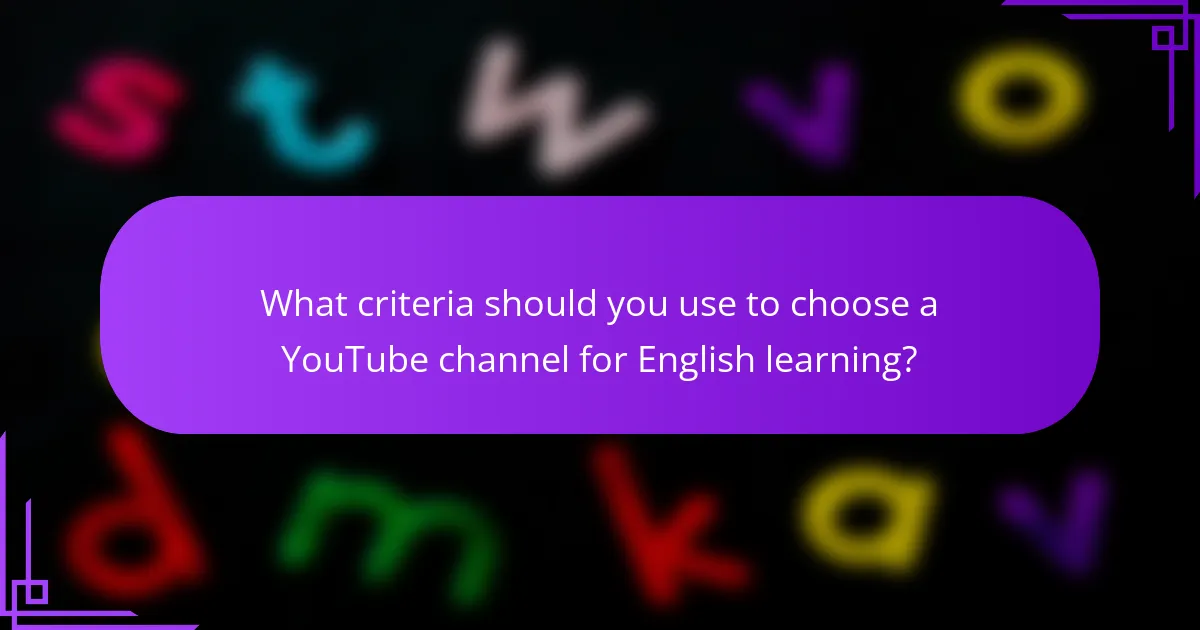
What criteria should you use to choose a YouTube channel for English learning?
When selecting a YouTube channel for English learning, consider factors like content quality, teaching style, and audience engagement. These elements significantly impact your learning experience and can help you achieve your language goals more effectively.
Content quality
Content quality is crucial for effective learning. Look for channels that provide well-structured lessons, clear explanations, and relevant topics. High-quality channels often use visuals, examples, and real-life scenarios to enhance understanding.
Check the frequency of uploads and the variety of subjects covered. Channels that regularly update their content and offer diverse lessons, such as grammar, vocabulary, and pronunciation, are generally more beneficial.
Teaching style
The teaching style of the presenter can greatly influence your learning. Some educators use a formal approach, while others may adopt a more casual, conversational tone. Choose a style that resonates with you and keeps you engaged.
Consider whether the presenter uses interactive elements, such as quizzes or prompts for practice. A good teaching style encourages active participation, which can lead to better retention of information.
Audience engagement
Audience engagement is a key indicator of a channel’s effectiveness. Look for channels that actively interact with their viewers through comments, live Q&A sessions, or community posts. This interaction can provide additional support and motivation.
Check if the channel encourages feedback and adapts its content based on viewer suggestions. Channels that prioritize audience input often create a more personalized learning experience, making it easier for you to stay committed to your language journey.
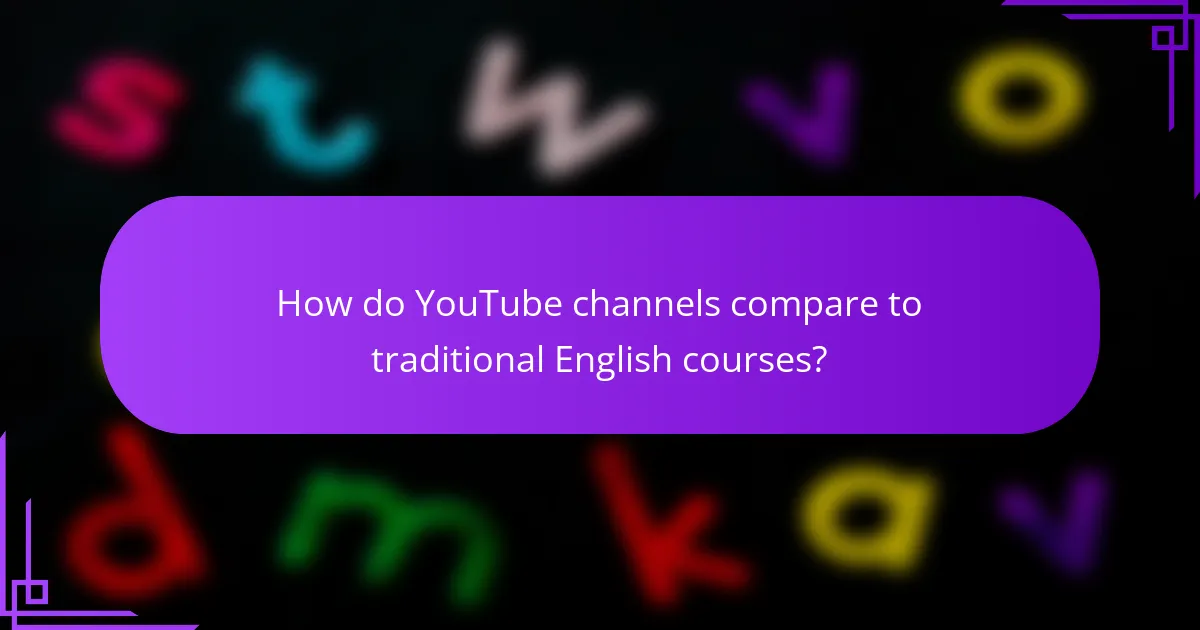
How do YouTube channels compare to traditional English courses?
YouTube channels offer a more accessible and often more engaging alternative to traditional English courses. While both methods aim to improve language skills, YouTube provides a unique blend of visual and auditory learning that can enhance retention and understanding.
Cost-effectiveness
YouTube channels are typically free, making them a cost-effective option compared to traditional English courses, which can range from hundreds to thousands of dollars. This accessibility allows learners to explore various channels without financial commitment, enabling them to find the style that suits them best.
Many reputable channels offer high-quality content, including lessons, quizzes, and interactive exercises, at no cost. This can significantly reduce the overall expense of learning English, especially for those on a tight budget.
Flexibility of learning
YouTube channels provide unparalleled flexibility, allowing learners to study at their own pace and on their own schedule. Unlike traditional courses that follow a set timetable, learners can choose when and how long they want to engage with the material.
This flexibility is particularly beneficial for busy individuals or those balancing work and study. Learners can revisit videos as needed, pause, or skip content that doesn’t resonate with them, tailoring their learning experience to their personal needs.
Access to diverse resources
YouTube channels offer a wide array of resources, including different teaching styles, accents, and cultural contexts. This diversity can enhance language acquisition by exposing learners to various forms of English, from conversational to academic.
Additionally, many channels incorporate real-life scenarios, interviews, and interactive challenges, providing practical language use that traditional courses may lack. This variety helps maintain learner engagement and can improve overall language proficiency.
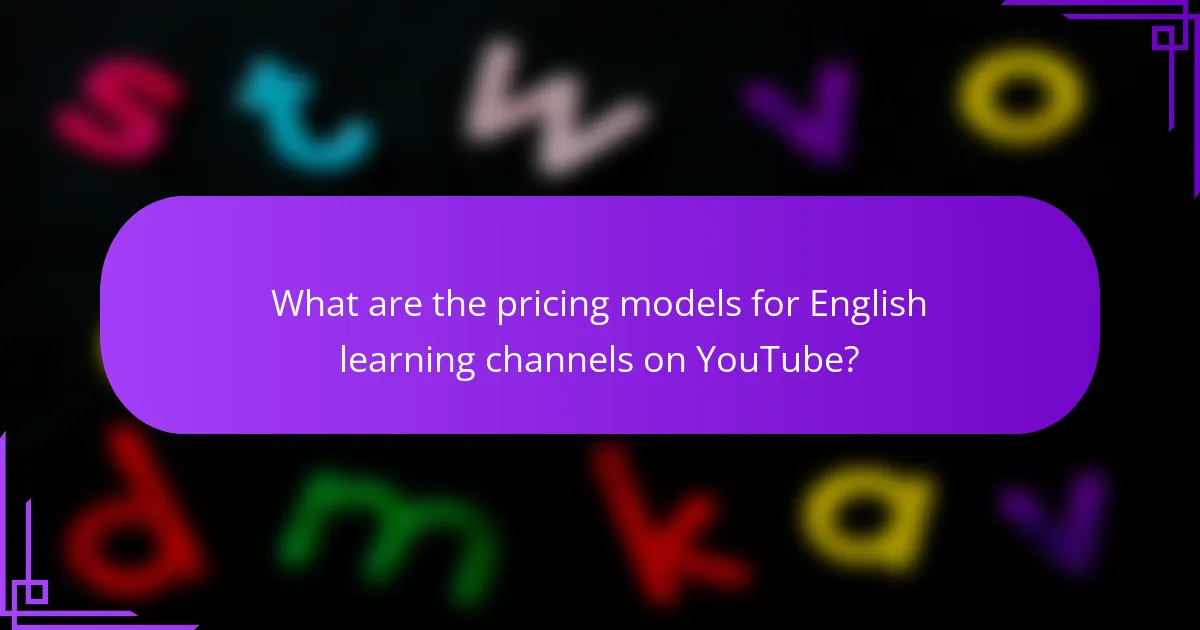
What are the pricing models for English learning channels on YouTube?
YouTube channels for English learning typically operate under two main pricing models: free content availability and subscription-based models. Understanding these options can help learners choose the best approach for their needs and budget.
Free content availability
Many English learning channels offer a wealth of free content, making it accessible to anyone with an internet connection. These channels often monetize through ads, allowing them to provide lessons, vocabulary tips, and grammar explanations without charging viewers.
While free resources can be beneficial, they may lack structured learning paths or personalized feedback. Learners should consider supplementing free content with additional resources or practice to ensure comprehensive language acquisition.
Subscription-based models
Some YouTube channels offer subscription-based models, where users pay a monthly fee for premium content. This may include exclusive videos, live tutoring sessions, or personalized study plans, often priced between $5 to $30 per month depending on the channel’s offerings.
Subscription models can provide a more structured learning experience and access to a community of learners. However, it’s essential to evaluate the value of the content offered and ensure it aligns with your learning goals before committing to a subscription.
